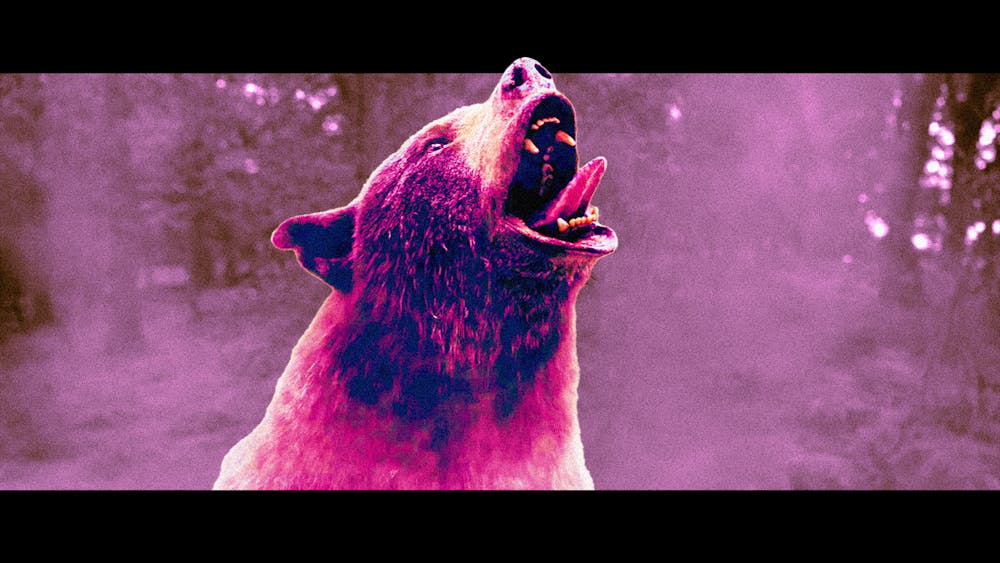The latest addition to the “Good for Her'' cinematic universe comes from an unlikely source. Alongside Midsommar’s Dani and Knives Out’s Marta, Cocaine Bear stands tall against the people trying to take her down. Now, the female protagonist is getting exactly what she wants: an insane amount of cocaine. Directed by Elizabeth Banks, the comedic thriller lives up to the genre by following the misadventures of the titular cocaine bear’s interactions with (and often slaughterings of) an assortment of characters. The film leans into the absurdity of the concept and remains self–aware throughout the entirety of its 95–minute run time.
The bulk of the film is dedicated to two plotlines taking place in the Chattahoochee–Oconee National Forest. While part of the movie follows mother Sari looking for her lost daughter Dee Dee in the forest, the other focuses on the drug kingpin Syd and his son Eddie searching for the lost shipment of cocaine located somewhere in the forest. The bear circulates the two groups while occasionally ripping apart side characters and searching for her next fix of the drug.
Shenanigans ensue as the two groups run blindly through the forest, searching for Dee Dee and the cocaine respectively. The bear's body count stacks up. From paramedics and teenage bullies to engaged hikers and park rangers, only the main characters seem to narrowly escape her jaws.
The film culminates with the two groups discovering each other in the bear’s cave, where it’s revealed that the cocaine bear is a mother and has two cocaine cubs of her own. In a fight to the death, the bear kills Syd, allowing Eddie, Sari, and Dee Dee to flee to safety. In an ending shot, cocaine bear and her two cubs happily play in a waterfall with their black fur covered in white powder. A happy ending for all.
The film’s release has been met with the general consensus between critics and audiences alike that the film is good for what it is. Unserious and gory, its entertainment lies in the sheer ridiculousness of the concept. As film critic James Berardinelli describes it, “Cocaine Bear is silly but it's not stupid.”
But Cocaine Bear isn’t entirely outlandish. There was once a real cocaine bear, although the true story is more of a tragedy than Banks’ screen adaptation. In 1985, drug smuggler Andrew Thornton died in the Chattahoochee–Oconee National Forest after attempting to parachute down—with about $15 million worth of cocaine on him. A few months later, the body of a black bear who had overdosed on cocaine was found in the same forest. Though there was no murder spree as seen in the movie, it was confirmed that the bear consumed at least three to four grams of cocaine. An even further rumor runs that the bear actually ingested all of the cocaine, about thirty–five pounds worth. However, there’s no concrete evidence to back up that claim.
The true story of Cocaine Bear is a tragedy. It's the death of a black bear at the hands of human carelessness and greed. In an interview with Variety, Banks said, “I really felt like this is so fucked up that this bear got dragged into this drug run gone bad and ends up dead. I felt like this movie could be that bear’s revenge story.” Banks held true to spinning a narrative that gave the bear a happy ending: with the drug dealers facing certain death and the bear walking away relatively unharmed, albeit addicted to the drug.
The film's entertainment value comes from the shock and gore of watching a high bear embark on a rampage through the forest. While it’s certainly not a watch for the faint of heart, beneath that bloody surface is perhaps a rewarding story of nature triumphing over human evil. The film actively works to place the blame on the people who put the bear in its position—mainly Syd—and treats the bear, mostly, as the victim she was.
As she and her cubs tear Syd apart in the final moments of the film, it's hard to not think “good for her.”







